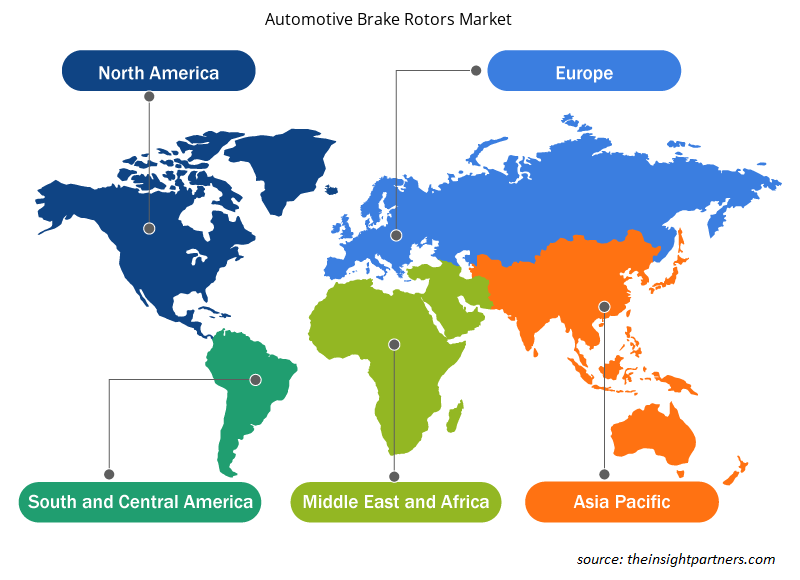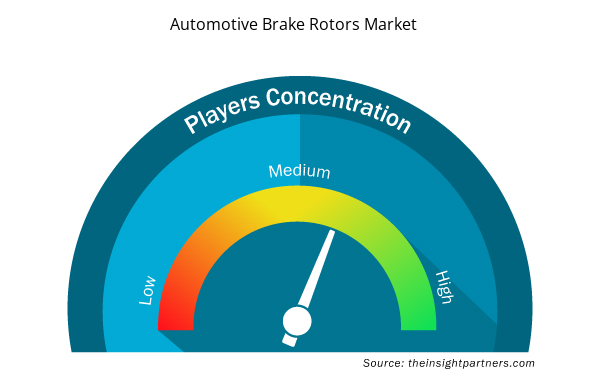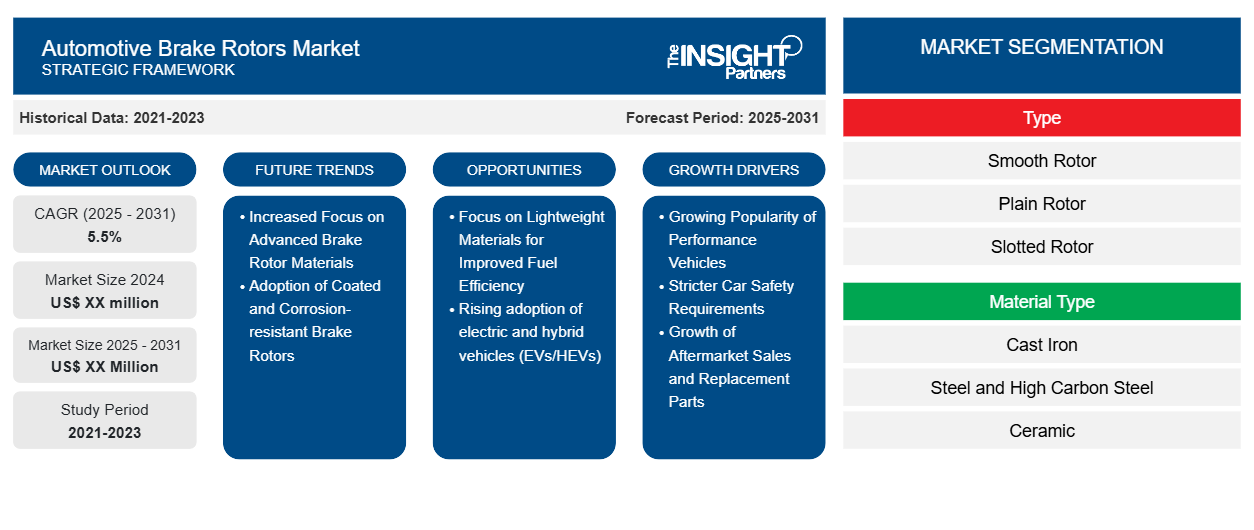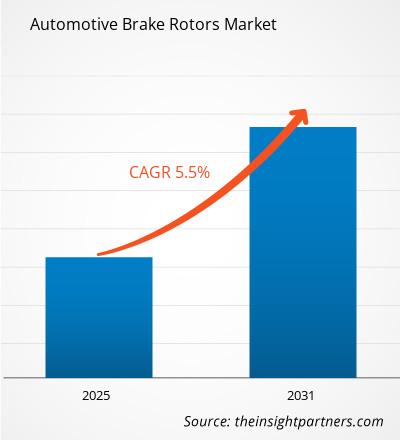Si prevede che il mercato dei rotori dei freni per autoveicoli registrerà un CAGR del 5,5% dal 2023 al 2031, con una dimensione di mercato in espansione da XX milioni di dollari nel 2023 a XX milioni di dollari entro il 2031.
Il mercato dei rotori dei freni per autoveicoli comprende l'analisi per tipo (rotore liscio, rotore semplice, rotore scanalato, rotore forato, altri), per tipo di materiale (ghisa, acciaio e acciaio ad alto tenore di carbonio, ceramica, altri), per tipo di veicolo (autovetture, veicoli leggeri, veicoli commerciali medi e pesanti) e geografia (Nord America, Europa, Asia Pacifico, Medio Oriente e Africa e Sud e Centro America)
Scopo del rapporto
Il report Automotive Brake Rotors Market di The Insight Partners mira a descrivere il panorama attuale e la crescita futura, i principali fattori trainanti, le sfide e le opportunità. Ciò fornirà spunti a vari stakeholder aziendali, come:
- Fornitori/produttori di tecnologia: per comprendere le dinamiche di mercato in evoluzione e conoscere le potenziali opportunità di crescita, consentendo loro di prendere decisioni strategiche informate.
- Investitori: condurre un'analisi completa delle tendenze in merito al tasso di crescita del mercato, alle proiezioni finanziarie del mercato e alle opportunità esistenti lungo la catena del valore.
- Enti di regolamentazione: regolamentano le politiche e le attività di controllo sul mercato allo scopo di ridurre al minimo gli abusi, preservare la fiducia degli investitori e sostenere l'integrità e la stabilità del mercato.
Segmentazione del mercato dei rotori dei freni per autoveicoli
Tipo
- Rotore liscio
- Rotore semplice
- Rotore scanalato
- Rotore forato
- Altri
Tipo di materiale
- Ghisa
- Acciaio e acciaio ad alto tenore di carbonio
- Ceramica
- Altri
Tipo di veicolo
- Autovetture passeggeri
- Veicoli leggeri
- Veicoli commerciali medi e pesanti
Geografia
- America del Nord
- Europa
- Asia-Pacifico
- America del Sud e Centro
- Medio Oriente e Africa
Geografia
- America del Nord
- Europa
- Asia-Pacifico
- America del Sud e Centro
- Medio Oriente e Africa
Personalizza questo report in base alle tue esigenze
Riceverai la personalizzazione gratuita di qualsiasi report, comprese parti di questo report, o analisi a livello nazionale, pacchetto dati Excel, oltre a usufruire di grandi offerte e sconti per start-up e università
- Scopri le principali tendenze di mercato in questo rapporto.Questo campione GRATUITO includerà analisi di dati che spaziano dalle tendenze di mercato alle stime e alle previsioni.
Driver di crescita del mercato dei rotori dei freni per autoveicoli
- Crescente popolarità dei veicoli ad alte prestazioni: la crescente popolarità dei veicoli ad alte prestazioni, come le auto sportive, le automobili di lusso e i SUV di fascia alta, è un altro fattore chiave del mercato dei rotori dei freni. I veicoli ad alte prestazioni spesso necessitano di sistemi frenanti aggiornati con maggiore potenza frenante, maggiore resistenza al calore e una maggiore durata. Poiché questi veicoli utilizzano spesso materiali di prima qualità come il composito di carbonio e i rotori ventilati, la necessità di rotori dei freni specializzati e ad alte prestazioni sta crescendo. Questa tendenza è particolarmente evidente in mercati come il Nord America e l'Europa, dove le vendite di veicoli ad alte prestazioni stanno aumentando rapidamente.
- Requisiti di sicurezza delle auto più severi: mentre i governi di tutto il mondo inaspriscono i requisiti di sicurezza delle auto, le prestazioni di frenata e la sicurezza sono diventate una priorità assoluta. Queste regole, che spesso includono elevate richieste di prestazioni di frenata, necessitano di sistemi frenanti migliorati e più duraturi, compresi i rotori dei freni. La spinta verso standard di sicurezza dei veicoli più rigorosi in tutte le regioni, in particolare nei mercati sviluppati come Europa e Nord America, sta determinando la necessità di sistemi frenanti migliorati, che a loro volta determinano la domanda di rotori dei freni di alta qualità.
- Crescita delle vendite aftermarket e dei pezzi di ricambio: la crescita del segmento aftermarket supporta l'espansione del mercato dei rotori dei freni per automobili. Con l'invecchiamento della flotta globale di veicoli, aumenta la domanda di rotori dei freni sostitutivi. I proprietari di veicoli devono riparare regolarmente i rotori usurati o danneggiati, il che crea una costante necessità di pezzi di ricambio per freni aftermarket. Inoltre, gli utenti che desiderano migliorare le prestazioni di frenata del proprio veicolo, in particolare per veicoli ad alte prestazioni o quelli con modifiche personalizzate, spesso si rivolgono all'aftermarket per rotori speciali. Questa continua domanda di componenti sostitutivi crea un potenziale significativo per i produttori di rotori dei freni per servire sia il consumatore generale che l'aftermarket delle prestazioni.
Tendenze future del mercato dei rotori dei freni per autoveicoli
- Maggiore attenzione ai materiali avanzati per rotori dei freni: il settore dei rotori dei freni per automobili sta assistendo a un passaggio verso nuovi materiali che migliorano le prestazioni, la durata e l'efficienza del peso. Il composito di carbonio, la ceramica e la ghisa ad alto tenore di carbonio stanno guadagnando popolarità perché sono più resistenti al calore, durano più a lungo e pesano meno dei tipici rotori in ghisa. I rotori in carbonio-ceramica, ad esempio, stanno diventando sempre più popolari nelle automobili ad alte prestazioni e di lusso grazie alle loro prestazioni di frenata superiori e alla capacità di resistere a temperature più elevate. La continua transizione verso materiali ad alte prestazioni e leggeri rimarrà una delle principali tendenze del settore.
- Adozione di rotori freno rivestiti e resistenti alla corrosione: un'altra tendenza importante nel mercato dei rotori freno per autoveicoli è il crescente utilizzo di rotori rivestiti e resistenti alla corrosione. I rotori freno sono sottoposti a condizioni ambientali estreme come umidità, sale e sostanze chimiche stradali, che possono causare ruggine e corrosione. I produttori stanno reagendo a questa sfida progettando rotori con rivestimenti protettivi, come superfici zincate o rivestite in ceramica, per aumentarne la longevità e le prestazioni, in particolare in aree con condizioni meteorologiche avverse. Questi rivestimenti aiutano ad aumentare la resistenza alla corrosione del rotore, migliorando la sicurezza complessiva e la durata del sistema frenante del veicolo.
Opportunità di mercato per i rotori dei freni per autoveicoli
- Concentrarsi sui materiali leggeri per una migliore efficienza del carburante: i produttori di rotori dei freni per autoveicoli hanno una significativa opportunità di sviluppare rotori leggeri composti da materiali innovativi come compositi di carbonio, alluminio o leghe di titanio. I rotori dei freni leggeri possono ridurre notevolmente il peso complessivo del veicolo, con conseguente maggiore efficienza del carburante e prestazioni. Con un'attenzione globale alla riduzione delle emissioni di carbonio e al miglioramento del risparmio di carburante, i rotori dei freni leggeri stanno guadagnando popolarità, in particolare per i veicoli elettrici, dove la riduzione del peso del veicolo è fondamentale per espandere l'autonomia di guida. I produttori che investono nella ricerca e nello sviluppo di questi materiali sofisticati saranno ben posizionati per sfruttare questa opportunità.
- Crescente adozione di veicoli elettrici e ibridi (EV/HEV): il crescente utilizzo di auto elettriche (EV) e veicoli elettrici ibridi (HEV) apre nuove potenzialità per i produttori di rotori dei freni. EV e HEV incorporano spesso sistemi di frenata rigenerativa, che riducono l'usura dei componenti dei freni standard. Tuttavia, questi veicoli necessitano ancora di rotori dei freni, soprattutto in situazioni di emergenza e quando la frenata rigenerativa è insufficiente. Inoltre, i sistemi di frenata EV devono essere sviluppati specificamente per gestire il peso del veicolo, le esigenze di prestazioni e le capacità di frenata rigenerativa. I produttori possono trarre vantaggio da questa tendenza realizzando rotori dei freni leggeri, robusti ed efficienti dal punto di vista energetico per veicoli elettrici e ibridi.
Approfondimenti regionali sul mercato dei rotori dei freni per autoveicoli
Le tendenze regionali e i fattori che influenzano il mercato Automotive Brake Rotors durante il periodo di previsione sono stati ampiamente spiegati dagli analisti di Insight Partners. Questa sezione discute anche i segmenti e la geografia del mercato Automotive Brake Rotors in Nord America, Europa, Asia Pacifico, Medio Oriente e Africa e Sud e Centro America.

- Ottieni i dati specifici regionali per il mercato dei rotori dei freni per autoveicoli
Ambito del rapporto di mercato sui rotori dei freni per autoveicoli
| Attributo del report | Dettagli |
|---|---|
| Dimensioni del mercato nel 2023 | XX milioni di dollari USA |
| Dimensioni del mercato entro il 2031 | XX milioni di dollari USA |
| CAGR globale (2023-2031) | 5,5% |
| Dati storici | 2021-2022 |
| Periodo di previsione | 2024-2031 |
| Segmenti coperti | Per tipo
|
| Regioni e Paesi coperti | America del Nord
|
| Leader di mercato e profili aziendali chiave |
|
Densità dei player del mercato dei rotori dei freni per autoveicoli: comprendere il suo impatto sulle dinamiche aziendali
Il mercato dei rotori dei freni per autoveicoli sta crescendo rapidamente, spinto dalla crescente domanda degli utenti finali dovuta a fattori quali l'evoluzione delle preferenze dei consumatori, i progressi tecnologici e una maggiore consapevolezza dei vantaggi del prodotto. Con l'aumento della domanda, le aziende stanno ampliando la propria offerta, innovando per soddisfare le esigenze dei consumatori e capitalizzando sulle tendenze emergenti, il che alimenta ulteriormente la crescita del mercato.
La densità degli operatori di mercato si riferisce alla distribuzione di aziende o società che operano in un particolare mercato o settore. Indica quanti concorrenti (operatori di mercato) sono presenti in un dato spazio di mercato in relazione alle sue dimensioni o al valore di mercato totale.
Le principali aziende che operano nel mercato dei rotori dei freni per autoveicoli sono:
- Freni EBC
- Robert Bosch GmbH
- Carbonio SGL
- Brembo SpA
- Azienda produttrice di freni Akebono.
Disclaimer : le aziende elencate sopra non sono classificate secondo un ordine particolare.

- Ottieni una panoramica dei principali attori del mercato dei rotori dei freni per autoveicoli
Punti chiave di vendita
- Copertura completa: il rapporto copre in modo completo l'analisi di prodotti, servizi, tipologie e utenti finali del mercato dei rotori dei freni per autoveicoli, fornendo una panoramica olistica.
- Analisi degli esperti: il rapporto è compilato sulla base della conoscenza approfondita di esperti e analisti del settore.
- Informazioni aggiornate: il rapporto garantisce la pertinenza aziendale grazie alla copertura di informazioni recenti e tendenze nei dati.
- Opzioni di personalizzazione: questo report può essere personalizzato per soddisfare le esigenze specifiche del cliente e adattarsi in modo appropriato alle strategie aziendali.
Il rapporto di ricerca sul mercato Automotive Brake Rotors può, quindi, aiutare a guidare il percorso di decodifica e comprensione dello scenario del settore e delle prospettive di crescita. Sebbene possano esserci alcune preoccupazioni valide, i vantaggi complessivi di questo rapporto tendono a superare gli svantaggi.
- Analisi storica (2 anni), anno base, previsione (7 anni) con CAGR
- Analisi PEST e SWOT
- Valore/volume delle dimensioni del mercato - Globale, regionale, nazionale
- Industria e panorama competitivo
- Set di dati Excel



Report Coverage
Revenue forecast, Company Analysis, Industry landscape, Growth factors, and Trends

Segment Covered
This text is related
to segments covered.

Regional Scope
North America, Europe, Asia Pacific, Middle East & Africa, South & Central America

Country Scope
This text is related
to country scope.
Domande frequenti
The report can be delivered in PDF/PPT format; we can also share excel dataset based on the request.
Some of the customization options available based on the request are an additional 3-5 company profiles and country-specific analysis of 3-5 countries of your choice. Customizations are to be requested/discussed before making final order confirmation, as our team would review the same and check the feasibility.
The major players in the market includes Brembo, Continental AG, Robert Bosch GmbH, Akebono Brake Industry, ZF Friedrichshafen AG, Aisin Ltd., HL Command, TRW Automotive, Autoliv, Inc., Eaton Corporation, and Others.
The Automotive Brake Rotors Market is estimated to witness a CAGR of 5.5% from 2023 to 2031
High manufacturing cost of the automotive brake rotors hinders the market growth.
The major factors driving the automotive brake rotors market are: Rising automotive production and sale across the globe with increasing demand for safety in the automotive sector drives the market growth.
Trends and growth analysis reports related to Automotive and Transportation : READ MORE..
1. EBC Brakes
2. Robert Bosch GmbH
3. SGL Carbon
4. Brembo S.p.A.
5. Akebono Brake Industry Co., Ltd.
6. Rotora
7. Federal-Mogul Corporation
8. Surface Transforms PLC
9. AISIN CORPORATION
10. CENTRIC PARTS
The Insight Partners performs research in 4 major stages: Data Collection & Secondary Research, Primary Research, Data Analysis and Data Triangulation & Final Review.
- Data Collection and Secondary Research:
As a market research and consulting firm operating from a decade, we have published and advised several client across the globe. First step for any study will start with an assessment of currently available data and insights from existing reports. Further, historical and current market information is collected from Investor Presentations, Annual Reports, SEC Filings, etc., and other information related to company’s performance and market positioning are gathered from Paid Databases (Factiva, Hoovers, and Reuters) and various other publications available in public domain.
Several associations trade associates, technical forums, institutes, societies and organization are accessed to gain technical as well as market related insights through their publications such as research papers, blogs and press releases related to the studies are referred to get cues about the market. Further, white papers, journals, magazines, and other news articles published in last 3 years are scrutinized and analyzed to understand the current market trends.
- Primary Research:
The primarily interview analysis comprise of data obtained from industry participants interview and answers to survey questions gathered by in-house primary team.
For primary research, interviews are conducted with industry experts/CEOs/Marketing Managers/VPs/Subject Matter Experts from both demand and supply side to get a 360-degree view of the market. The primary team conducts several interviews based on the complexity of the markets to understand the various market trends and dynamics which makes research more credible and precise.
A typical research interview fulfils the following functions:
- Provides first-hand information on the market size, market trends, growth trends, competitive landscape, and outlook
- Validates and strengthens in-house secondary research findings
- Develops the analysis team’s expertise and market understanding
Primary research involves email interactions and telephone interviews for each market, category, segment, and sub-segment across geographies. The participants who typically take part in such a process include, but are not limited to:
- Industry participants: VPs, business development managers, market intelligence managers and national sales managers
- Outside experts: Valuation experts, research analysts and key opinion leaders specializing in the electronics and semiconductor industry.
Below is the breakup of our primary respondents by company, designation, and region:

Once we receive the confirmation from primary research sources or primary respondents, we finalize the base year market estimation and forecast the data as per the macroeconomic and microeconomic factors assessed during data collection.
- Data Analysis:
Once data is validated through both secondary as well as primary respondents, we finalize the market estimations by hypothesis formulation and factor analysis at regional and country level.
- Macro-Economic Factor Analysis:
We analyse macroeconomic indicators such the gross domestic product (GDP), increase in the demand for goods and services across industries, technological advancement, regional economic growth, governmental policies, the influence of COVID-19, PEST analysis, and other aspects. This analysis aids in setting benchmarks for various nations/regions and approximating market splits. Additionally, the general trend of the aforementioned components aid in determining the market's development possibilities.
- Country Level Data:
Various factors that are especially aligned to the country are taken into account to determine the market size for a certain area and country, including the presence of vendors, such as headquarters and offices, the country's GDP, demand patterns, and industry growth. To comprehend the market dynamics for the nation, a number of growth variables, inhibitors, application areas, and current market trends are researched. The aforementioned elements aid in determining the country's overall market's growth potential.
- Company Profile:
The “Table of Contents” is formulated by listing and analyzing more than 25 - 30 companies operating in the market ecosystem across geographies. However, we profile only 10 companies as a standard practice in our syndicate reports. These 10 companies comprise leading, emerging, and regional players. Nonetheless, our analysis is not restricted to the 10 listed companies, we also analyze other companies present in the market to develop a holistic view and understand the prevailing trends. The “Company Profiles” section in the report covers key facts, business description, products & services, financial information, SWOT analysis, and key developments. The financial information presented is extracted from the annual reports and official documents of the publicly listed companies. Upon collecting the information for the sections of respective companies, we verify them via various primary sources and then compile the data in respective company profiles. The company level information helps us in deriving the base number as well as in forecasting the market size.
- Developing Base Number:
Aggregation of sales statistics (2020-2022) and macro-economic factor, and other secondary and primary research insights are utilized to arrive at base number and related market shares for 2022. The data gaps are identified in this step and relevant market data is analyzed, collected from paid primary interviews or databases. On finalizing the base year market size, forecasts are developed on the basis of macro-economic, industry and market growth factors and company level analysis.
- Data Triangulation and Final Review:
The market findings and base year market size calculations are validated from supply as well as demand side. Demand side validations are based on macro-economic factor analysis and benchmarks for respective regions and countries. In case of supply side validations, revenues of major companies are estimated (in case not available) based on industry benchmark, approximate number of employees, product portfolio, and primary interviews revenues are gathered. Further revenue from target product/service segment is assessed to avoid overshooting of market statistics. In case of heavy deviations between supply and demand side values, all thes steps are repeated to achieve synchronization.
We follow an iterative model, wherein we share our research findings with Subject Matter Experts (SME’s) and Key Opinion Leaders (KOLs) until consensus view of the market is not formulated – this model negates any drastic deviation in the opinions of experts. Only validated and universally acceptable research findings are quoted in our reports.
We have important check points that we use to validate our research findings – which we call – data triangulation, where we validate the information, we generate from secondary sources with primary interviews and then we re-validate with our internal data bases and Subject matter experts. This comprehensive model enables us to deliver high quality, reliable data in shortest possible time.


 Ottieni un campione gratuito per questo repot
Ottieni un campione gratuito per questo repot